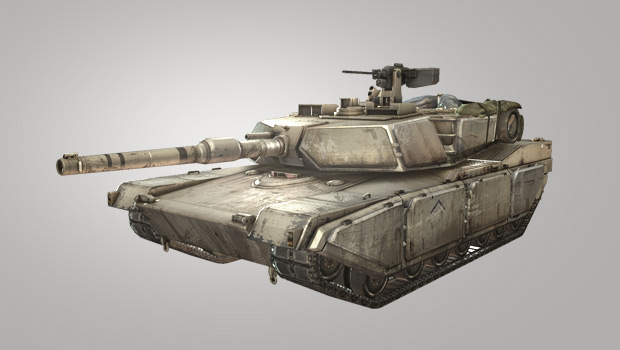
The M1A3 is the next generation design of the M1A2 Abrams, designed to synchronize its high tempo, distributed maneuver via its digitized situational awareness and the fusion of on-board and remote battlefield sensors.
The driver controls the 144mm main cannon and the counter measures system for defeating rockets and grenades, while the second crew member controls the remote .50 caliber canon mounted on top of the vehicle.
M1B Fuller:
The M1B Fuller, also known as the "Mib", contains the best aspects of both American and British tank technology, allowing it to server as the Western Coalition's most effective heavy tank.
 Named after one of the original fathers of the armored warfare doctrine,
British Major-General JFC Fuller, the Fuller is a slow gas-guzzled that
is capable of dealing out, and taking, extreme amounts of damage.
Named after one of the original fathers of the armored warfare doctrine,
British Major-General JFC Fuller, the Fuller is a slow gas-guzzled that
is capable of dealing out, and taking, extreme amounts of damage.The M1B supports two crew members. The driver controls a powerful 120mm advanced propulsion main gun, a 7.62 mm coaxial light machine gun, and a Firefly decoy launcher. The second crew member controls a 12.7mm heavy machine gun through a camera system safely inside of the vehicle. Both crew members share target and threat information using the Shared Targeting System.
Vehicle operators are situated in the base of the tank and the turret and weaponry is wire-operated. The secondary gun position shows an advancement to previous tank designs in not exposing the gunner, but instead using a camera system from safely inside the vehicle.
 The M1B’s main gun, a 120mm advanced propulsion cannon, is an
interesting and deadly piece of work. It has a much higher velocity than
a conventional 120mm due to the use of a new gun propulsion technology
called elector-thermal chemical (ETC). An elector-thermal gun fires a
projectile with as much as 50% more kinetic energy as standard gun of
the same diameter and length, which it does by injecting a powerful
charge of electricity into the ignition-combustion chamber of the shell
(whereas a standard shell simply relies on a low-order explosive primer
to ignite the shell’s main charge). This electrical surge imparts
additional energy to the warhead as it travels down the barrel,
permitting acceleration the entire time the warhead is in the barrel
(whereas the warhead of a standard shell begins to decelerate the moment
after ignition, even while in the barrel).
The M1B’s main gun, a 120mm advanced propulsion cannon, is an
interesting and deadly piece of work. It has a much higher velocity than
a conventional 120mm due to the use of a new gun propulsion technology
called elector-thermal chemical (ETC). An elector-thermal gun fires a
projectile with as much as 50% more kinetic energy as standard gun of
the same diameter and length, which it does by injecting a powerful
charge of electricity into the ignition-combustion chamber of the shell
(whereas a standard shell simply relies on a low-order explosive primer
to ignite the shell’s main charge). This electrical surge imparts
additional energy to the warhead as it travels down the barrel,
permitting acceleration the entire time the warhead is in the barrel
(whereas the warhead of a standard shell begins to decelerate the moment
after ignition, even while in the barrel).
No comments:
Post a Comment